You know very well by now that this detective agency has a staff of one. And this one likes to wander off. I pretend at times that there is a crabby clerk to whom I am tethered. Mr. Cross, the office clerk. His sole purpose would be to answer the telephone, mostly a tip line. We have a little 1940s office front, in my daydream, similar in feel to that real detective, who at one time, had hung his shingle where Spruce Gifts is now located at 50th and Leavenworth. Do you remember his keen office?
Image originated from work by Eugenio Garcia Villarreal.
Mr. Cross would man that old, heavy, black receiver with a rotary dial, sit with his linen leg crossed at a worn, wooden desk, (or was it a steel Tanker?), wears impeccable ties every day and smokes Chesterfields his whole shift while I am out snooping around. “My Omaha Obsession Amateur Detective Agency,” he’d snap with a transatlantic accent. “No. No. No. I don’t know where Miss Cassette has run off to. You know how she is…” He would smack of Cary Grant but act just like the Boris Lermontov character in the Red Shoes.

Difficult. He is very persnickety. Okay, I will confess, he is allowed another clerical duty. His meticulousness dictated that he be an excellent filer. I could see that strange skill in his disposition and I took him up on his fixation. Like a compulsive fit, he’d file these piled newspaper articles, catalog the endless Omaha and architecture books, marshal My Ideas Folders, endless notebooks, square away my digital records and systematize all of these untidy photos. Oh yes, and Photoshop! He’d be a real whiz at it. He could fuss them into good order. But eventually his patience would wear thin and he’d leave for the day in a fine snit. If he’d looked like Robert Mitchum, I would have begged him to stay.
Mr. Cross would have answered the telephone that fall day when Donna Huber of Thirteen Moons Acupuncture reached out to My Omaha Obsession. “A patient of mine gave me your blog address today, thinking that you may be able to direct me to finding more information out on the property that my acupuncture clinic sits on.” In all actuality, Donna had sent me an email with those very words but allow me to continue narrating this daydream involving Mr. Cross. In my fantasy Cross transcribed Donna’s words on a small, fine pad of paper. “Who was the original family?” “Needs to know the history!” “Haunted” and “Magical Property.” When I got back to the smoky office that night, Mr. Cross was long gone but I found that intoxicating checklist on my desk. And I was immediately hooked.
1000 and 1002 North 72nd Street
Donna Huber
Thirteen Moons Acupuncture
I knew just the place!
The Rumor
I communicated with Donna by email. She knew very little about the property, which she had purchased in 2014 for her growing acupuncture business. She confided in me that previous to buying the large home she had been warned about its “bad energy” from a “some people.” The home was rumored to be inhabited by some upset children, ghosts, I should say…particularly a mad, little boy. Donna had the house cleared, just to be safe. We will get into all of that excitement later. But I will let you know that in speaking to various friends about my research of this property, I was to learn that the ghostly legend of the house at 72nd Street was well known around town. And in all of the years of Omaha living, I never heard boo about it.
What follows is the story of my search to find out the truth about 1002 North 72nd Street and of course, many of my side journeys and dalliances. I quite literally got stuck in this story…emotionally involved, so to speak. The house and its people have been in my dreams for months. This was my longest, knottiest investigation yet but endlessly fascinating to me. This one’s for Donna.
Memories and Preparations
I began digging for clues in full this winter. I wanted to know as much about the neighborhood and surrounding environs as I could. I was familiar, or thought I was, with this strip of 72nd Street. Growing up in Benson, I had seen the farmhouse in the trees umpteen times as my bus passed by on the way to Crossroads Shopping Center. This was the big house in the trees on the way to Rose Lodge. I had seen this house peeking at me on the way to my father’s barber in the West Lanes Bowling Center. Hadn’t Ronald J. Palagi reconfigured this home into attorneys’ offices at some point? Anyone from Benson could tell you that 72nd Street was one of our main thoroughfares to the center of town and most children from those days had determined that 72nd Street had redirected and hand- delivered the tornado’s fateful path straight into Benson in May of 1975. I have many things I think I know about our city that are oftentimes incorrect.
Google street map. Map image taken from Google site.
Because of my child’s preconceived notion of this area, I was compelled to survey this fascinating locale with adult eyes. Read that as Snoop Around A Bit. 1002 North 72nd Street is at the southwest corner of 72nd and Izard Street. Izard Street, in this part of town, is four blocks north of Dodge. This is not the case in other parallel neighborhoods, thanks to the weaving and wandering of Old Omaha roads. A solid, beautiful home, 1002 appeared to have been an American Foursquare with many contemporary updates, making it more suitable to a business operation. It was sided in a sightly pale gray with white trimmed windows. Everything was quite orderly. The original front door was on the east side of the house, facing 72nd Street. Whether it was still in use was suspect as there was no longer a path to the door.
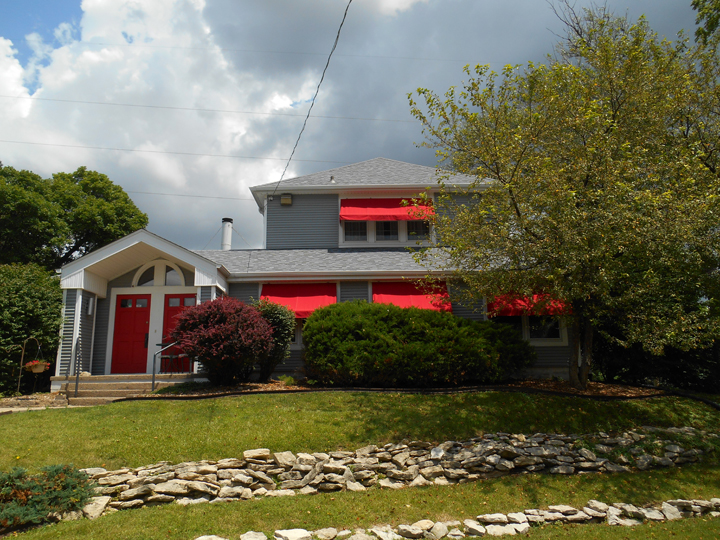
I also surveyed the west of the house or what one might have thought the traditional “back of the house,” which I ascertained was now used as the front door to the acupuncture business.

Two bold, mysterious, red doors, in fact. Quite attractive. There were also crisp red, real awnings, not these silly new awnings they are trying to foist on us. I was immediately drawn to the way in which the house was placed on the land, with the west elevation facing a lower, private area.
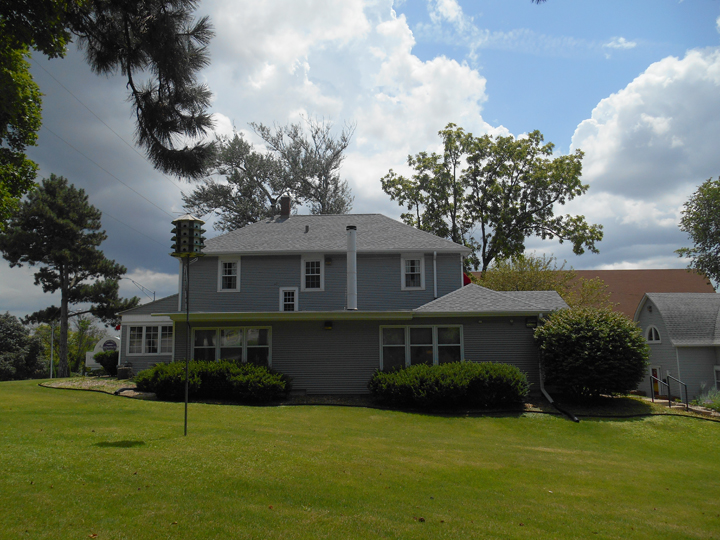
North elevation. I spied what looked to be an addition.
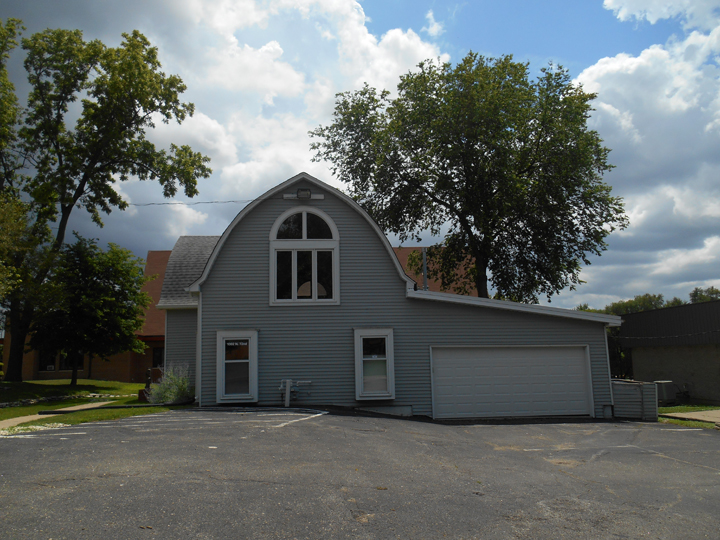
And then I eyeballed the fantastic looking, smaller outbuilding behind the farmhouse, which I assumed to be a refurbished barn. It had a cunning gabled roof and tidiness that I sensed the imaginary Mr. Cross would approve of. Could this be Miss Cassette’s new detective agency?
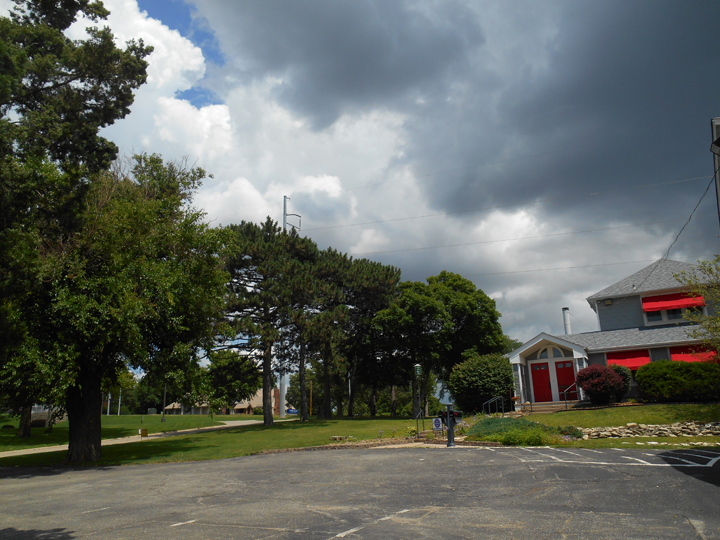
The trees on the property were of the Long-Range View variety. Do you know what I mean? Towering. Learned. I guessed the mix of Pines, a Mulberry, and a fantastic mystery tree to be at least one hundred years old, most likely an old shelterbelt surrounding the farmhouse. I also discovered Cedars that might have been from the 1950s on a western border, along with some newer Crabapples snuggling up near the home. There was whispering amongt the older trees, a private, shared language but not because there was a guest nosing around. The evening dramatization was helped immensely by an impending storm that had whipped up. The quality of air is exceptional on this corner considering 72nd Street is so near. I don’t know that I was even aware of the steady stream of traffic beyond the Pines. After having experienced this a few times, I will go on record and say that exploring a property right before a good storm can tell you a great deal. I just stood there, nestled between the barn and the house and took it all in, as big gusts whirled my detective blouse and hair about.
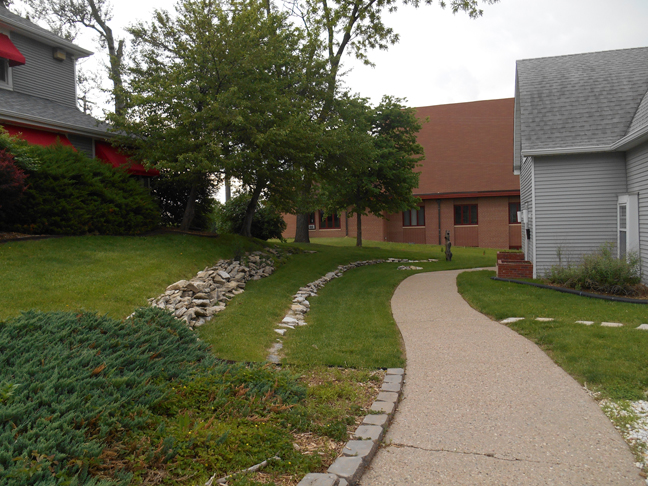
For the record I only felt good, steady energy. It was breathtaking to be walking that property, With Permission, one that I had viewed from 72nd Street my whole life.
More Notes
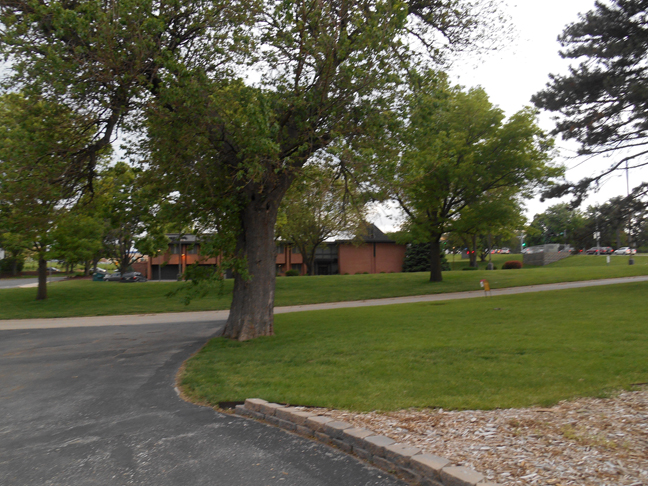
The John A. Gentleman funeral home was witnessed to the north of the house and Creighton Prep High School just beyond. The Seventh Day Adventist church is to the south and further down, alongside 72nd Street, Lewis and Clark Junior High, now called Middle School, has their campus track. 72nd Street continues to be very busy along this stretch as it has been through my life. There are numerous cute, little Ranch and Split-Level houses to the east and west of the farmhouse, obviously part of a later development. Other than the friendly green American Foursquare a few doors down at 822 North 72 Street, and the Mystery House-Turned Church catty corner at 1025 North 72 Street, I could view no other contemporaries of the proud gal at 1002. I jotted these observations down in my notepad.
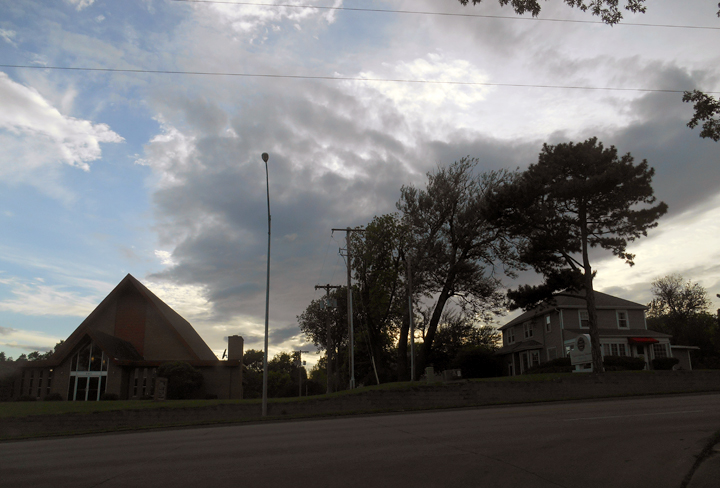
Seventh Day Adventist Church to the south of the home. Notice the southern shelter belt lining 1002 North 72nd Street and the storm coming in on that blustery evening.
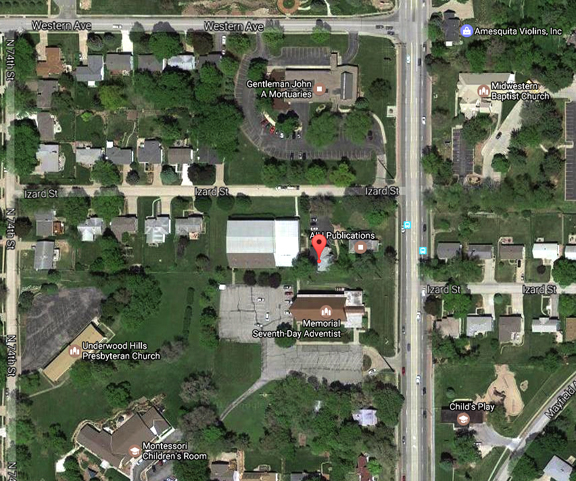
Google Map image with trees. Map image taken from Google site.
Early Steps
I knew I would need proper evidence so I headed to the Downtown Omaha W. Dale Clark Public Library. Or maybe I just like to start all mysteries there? It’s kind of my habit. In all truthfulness, I believe I began late one night at the Douglas County Assessor’s site.
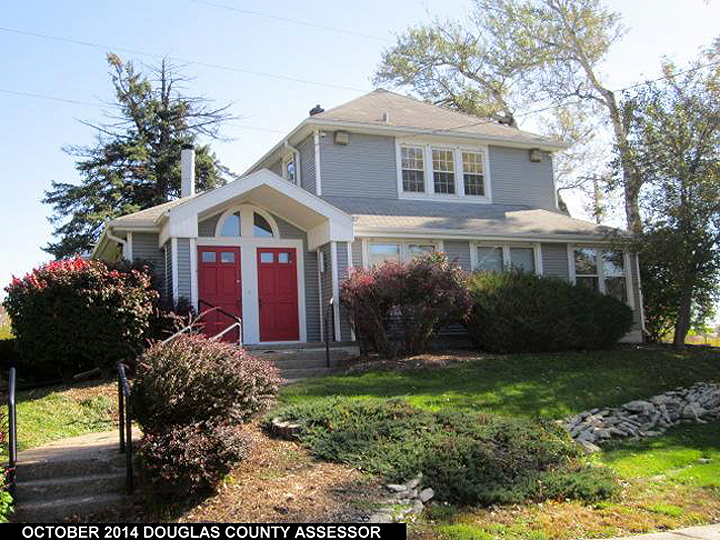
The County Assessor estimated the home to have been built in 1912. As an aside, these dates are not always correct.

The Assessor reported the square footage at 3,192. The property had apparently been remodeled in 2000. The fixed up barn was also thought to have been originally built in 1912 and was renovated in 1988. It appeared that it might have been renovated in 2000 along with the house.
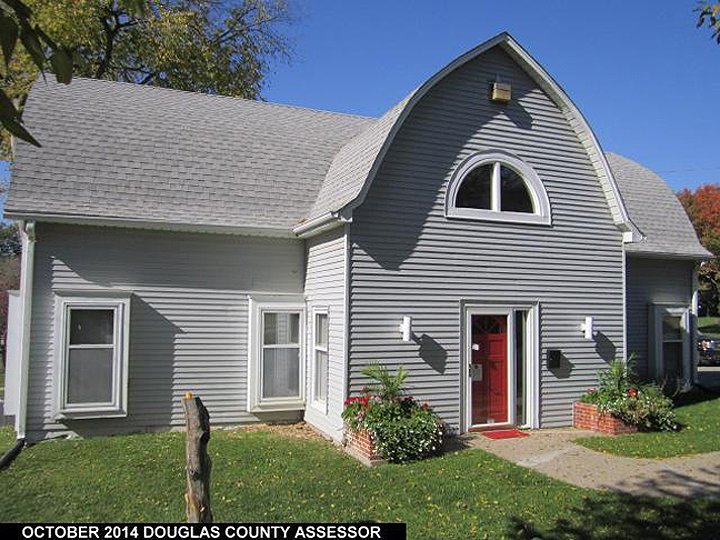
East elevation of the barn.

The barn alone was estimated at 2,452.0 sqft. The property lot size is 28,510.0 sqft. The legal description or neighborhood is called the Bellair Addition. The smaller houses to the west of the farmhouse were considered Bellair Replat, which made sense for a later addition. I was puzzled by a queer little real estate site, which listed the home as having been erected in 1965 and at 5,554 sqft, obviously a total. I would make a note of it regardless.
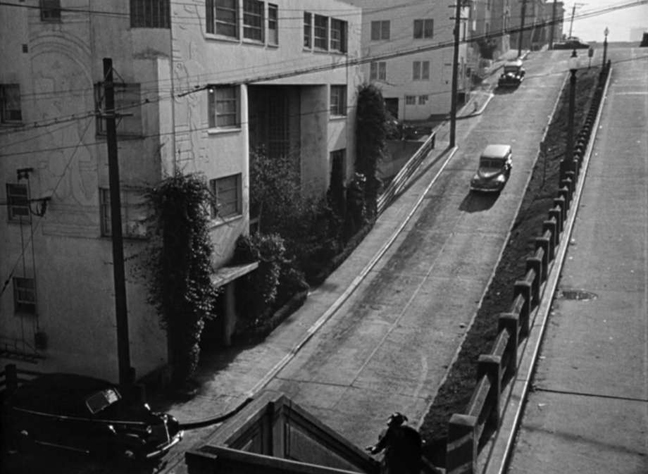
May I confess to you that as excited as I was, I was also cautious straight away? I had previously learned on another adventure that houses in this vicinity were typically difficult to track. Historically speaking: Not quite part of the town of Benson and definitely not part of the city of Omaha, therein laid the predisposed anxiety about 72nd Street in the suspected year 1912. But my sleuthing instincts were keenly piqued and I didn’t want to give Mr. Cross an excuse to return a call to Donna Huber of Thirteen Moons explaining I was a good-for-nothing layabout.
As I recollect, fellow operatives, this is the point in which I believe I visited the library. At least I think I did. Some in the crowd will surely retort, “Who cares?” and “What’s with the little idiosyncrasies, Miss Cassette?” or “Get on with it, already!” but you see, I am in a playful mood today because I know how the mystery ends. And I want us to just linger here a bit and be on these slow terms with one another. Yes, I know this is quite a torturing habit and the murderous sorts of instincts this might rouse in the impatient among us. Might I suggest putting the Luiz Bonfa Solo in Rio 1959 record on the player and calming oneself? This is not a rush-about situation here at My Omaha Obsession.
72nd Street The Early Years
Okay, let’s get serious, shall we? If the 1002 North 72nd Street home was indeed built in 1912, I had assumed that 72nd Street was not yet named as such as it had not been absorbed into the City of Omaha.
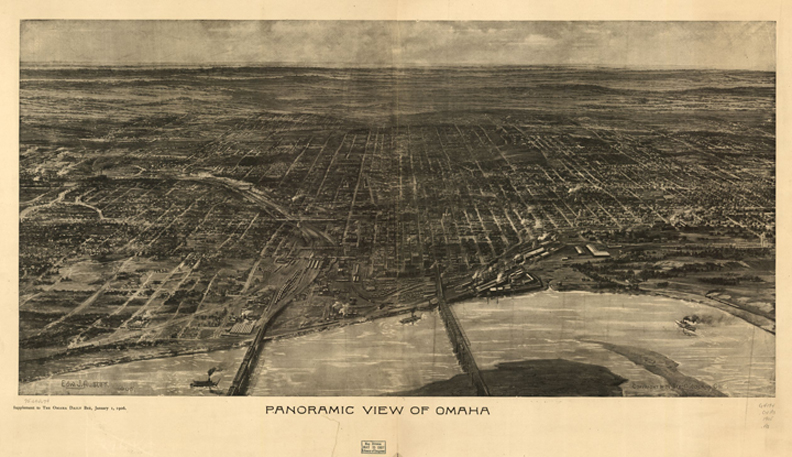
Daily Bee 1906
In this fantastic panoramic supplement to the Omaha Daily Bee, dated January 1, 1906, one can see that although Omaha had spread north and south along the Missouri River, it had not developed very far west. In consulting with H. Ben Brick’s The Streets of Omaha: Their Origins and Changes, he mentions very little about 72nd Street along this belt, other than hinting parts of 72nd were a country road originally. By searching local newspapers, I found first indication of “72nd Street,” sometimes “72d St,” or variations thereof, in an advertisement of May 15, 1921. In it, a landowner was selling his property “Country Home with Attractive Site and Grounds.”

OWH May 15, 1921. 72nd Street just west of city limits on a mecadimized road. What in the world was that? I later realized it was a misspelling of a macadamized road.
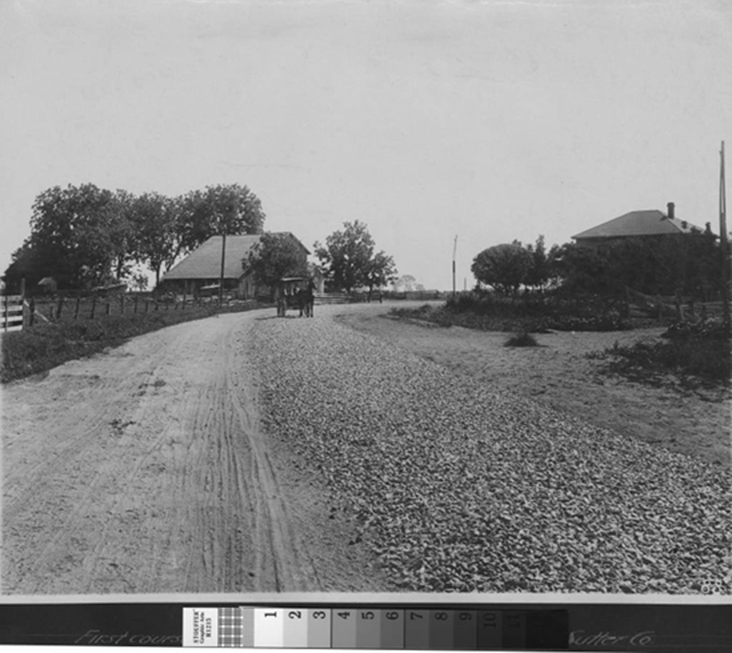
Macadamized road from the 1850s. California.
Either straight macadam, water-bound or tar-bound, John Loudon McAdam’s invention, the “macadam road” was a simple method of covering native soil with a “road crust” of small rocks. We, Omahans, have all driven this type of rocky road, being good country folk once or twice removed, but some in the bunch perhaps were not aware this road had an actual name. Now we know.
The homes along 72nd or therein were often referred to as a “beautiful country home” and from 1924 “five acres west of Fairacres, sightly property off 72nd Street (to be paved).” What we gain from these clues is that 72nd was a country road, a rural route, so to speak, and was considered “west of Fairacres” at least where 72nd and Izard is concerned. Also of note, 72nd might not have been paved until the 1920s. Put this down in your own wording, Sherlock.
The Real Beginning for Fretful Friends
Since some of you, whether you will admit it or not, seem liable to just scan or stray all willy-nilly through these pages of text, I will begin to lay down my findings. Because there were bonafide findings, they were just not as tidy as I would have liked. In the hands of a very different writer, say a historian, this is where one might have begun with the tale. Edward Krisel owned the original plat where 1000 and 1002 North 72nd Street is positioned. 1002 is considered Lot 37 of Block 0, according to Book 18 at the Douglas County Deeds office. It is interesting to note that Mr. Krisel also owned Lots 35, 36, and 38. Beyond that, I could find no other adjacent lots possessed by Mr. Krisel. Later I would discover he owned other real estate in Benson.
The Edward L. Krisel File
My first clue about the Krisel family revealed that in 1909, years before 1002 North 72nd was even built or so I thought, Edward L. Krisel was selling a fine family cow. His postal box was located in Benson, which most likely was the closest town to this swath of land he owned along 72nd. OWH August 1909: “For sale family cow. Fine fresh Jersey. only $45. Edward Krisel, Benson. R. F. D. No. 1 Box 16. Different box numbers over the years were taken into evidence.
From the Typographical Journal of 1902 Volumes 20-21, an International Typographical Union book about the printing industry I unearthed, “Omaha, Nebraska. Edward Krisel, age 26 years; served apprenticeship with the American Publishing Company, Omaha; now working in his own office.” Through the Nebraska Department of Labor report of 1907, I was able to track Edward Krisel’s business at 315 South 12th Street.
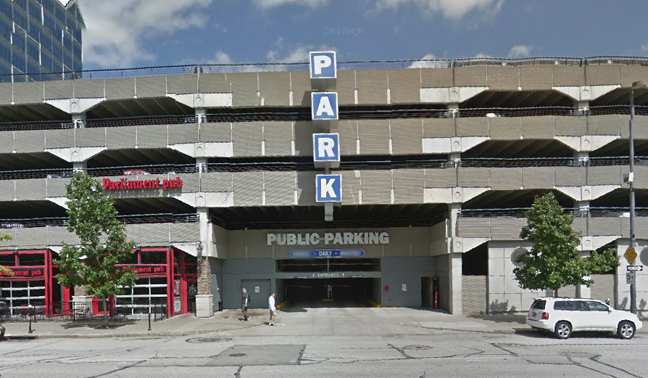
315 South 12th, 12th and Harney. Krisel’s first office as a publisher was located where this Old Market parking structure is today.
Krisel would later pull up stakes and move his publishing business to the basement of the Merchant’s Drugstore, later called Merchant’s Pharmacy, on 16th and Howard. I found evidence of this longstanding Omaha drugstore dating back to 1897. Edward Krisel apparently had an unusual habit of which he was known for around town. According to an OWH article from 1944, “Another colorful Omahan years ago was Edward Krisel the printer, who had a shop in the basement of the Merchants Drug Store, at Sixteenth and Howard Streets.” As the story goes, before each New Year, Krisel used to collect as much money as he could from persons who owed it to him, turn “other things” into cash and have it all on hand when the New Year arrived.” Hello…Mr. Pinchpenny. Sensible, some might say.
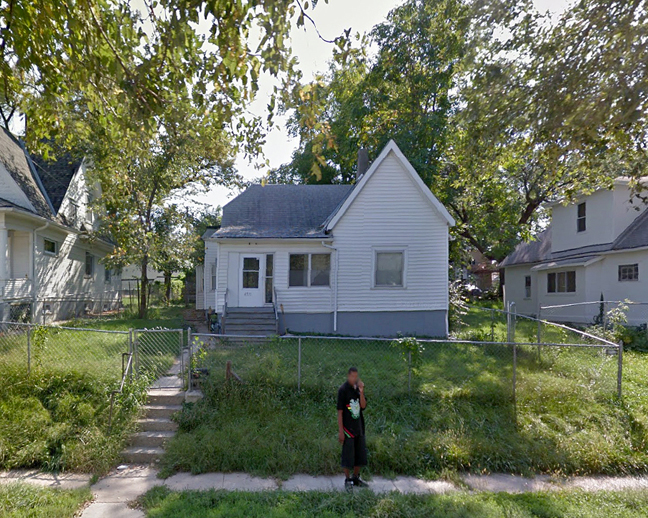
Edward Krisel also owned this sweet gabled storybook cottage at 4311 Erskine that he put up for sale in 1913. According to the Assessor’s office this home was built in 1895. I am pretty sure this is considered the Benson area. I am not sure if this was the Krisel family home or one of many homes he owned. “Five-room, cozy cottage, partly modern. Priced at $2,150. Edward Krisel, 4311 Erskine.”

Mrs. Krisel, on the other hand, was a well-known member of the Red Cross “knitting unit” in August of 1917. The knitters would evidently meet in downtown Benson or at various fellow knitters’ homes. I was curious about what this could mean and as it turns out, Mrs. Krisel was right with the times. Reportedly the United States government encouraged American citizens to knit during World War I. These volunteer Red Cross knitting units handily made wool socks, scarves, sweaters and wristlettes to be shipped to the American soldiers throughout 1917. This is amazing to think about.
A most telling article from 1940 announced Mrs. Krisel as president of the local Women’s Christian Temperance Unions: a group that communally prayed (reputedly often) that the people of the United States would go back to worshipping God. This familial focus on Christianity was later reflected in the findings of the Krisel’s daughter, Miss Vivian Elizabeth.
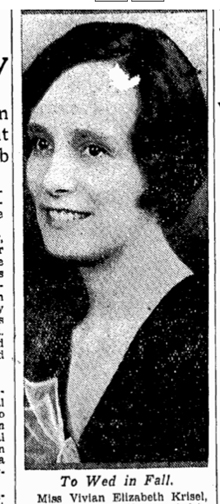
And now presenting, the June 10, 1934 wedding announcement of Miss Vivian Elizabeth.
Vivian Elizabeth was a National Honor Society student while at Central High School, a bachelor degree and a master of religious education from Biblical Seminary in New York City. Miss Krisel would meet and marry Dr. Edward P. Blair who was later an associate professor of English Bible at the Garratt Biblical Institute on the Northwestern University campus. By 1944 the couple would live in Evanston, Illinois and have two daughters, Phyllis and Sharon Louise.
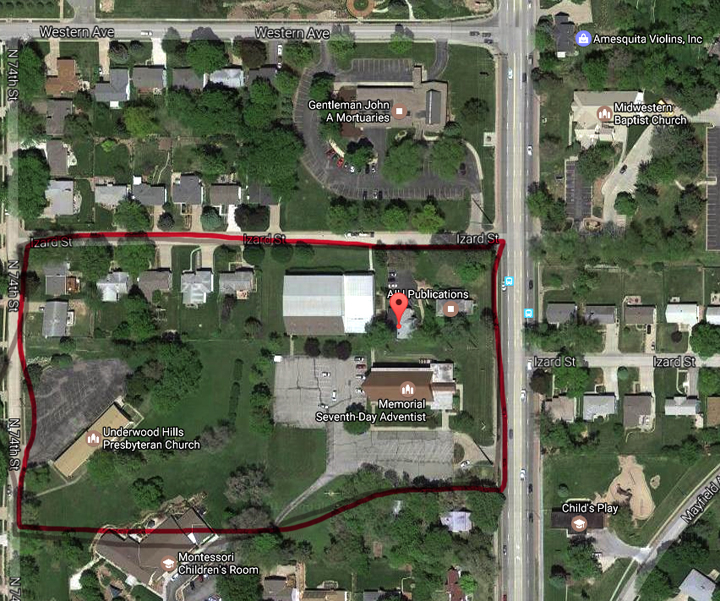
As stated in the archives of the Register of Deeds office, Edward L. Krisel and wife sold Lots 35, 36, 37,and 38 to Benjamin Porter on October 21, 1910. While we have the proof that Krisel originally owned the acreage, I cannot say for sure that his family ever resided on this farmland. My years of meddling and predisposition to hatch complicated tales, leads me to give an explanation. Taking into account that Krisel liked to watch his pennies, I believe the publisher might have bought the land early on as an investment. I cannot imagine someone being able to farm and run a publishing business. Then again many prominent Omaha families had farms in this time period, even though they ran banks and department stores. It is also possible that he inherited the land from his family. That would explain his selling of the cow in 1909, antecedent to the 1910 sale to Porter. This wobbly red line is what I believe was the original farm boundary.
The Benjamin Porter Evidence
A maddening search of the Omaha Public Library city directories showed very little from 1910-1915. By 1915 there was not only no clues to 72nd and Izard in the reverse (by address) street guide, there was no Benjamin Porter listed under the alphabetical surnames guide. I made excuses that 72nd and Izard was not within the Omaha city limit. Amateur Detective Tip: Using the directories for older outlying neighborhoods that were initially country or suburbs are often difficult to find for the years before annexation to a city.
Appraising the United States Census of 1910, I found the Porter family living somewhere along the blocks of 18th and Reed. Census records are a detective’s dream, as they often reveal the names of everyone in a house and their relationship to one another.
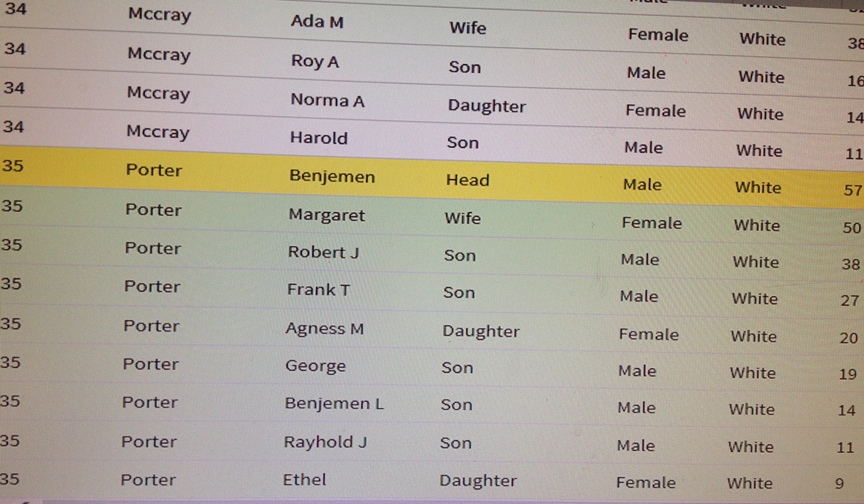
US Census 1910. Located “18th” and “Reed Street,” within Benson City, Douglas County, Nebraska. My Very Word…. those are a lot of children! And they all lived at home?

The United States Census of 1920 uncovered the Porter clan living on Rte. 6 in “Dundee, Douglas County.” Benjamin Porter was “interview 51” and was age 66. I found, through his answers, that he was born in 1869 in Essex, England. His parents were from England. His occupation was “Farmer.” Margaret, his wife, was then 59. She was born in Pennsylvania and her parents were from Ireland. At that point only sons George and Raymond (both single) were living at the home and were listed as farmers/caretakers of the family farm. Where had all of the children gone? But more importantly how were a Englishman and an Irish Lassie to get along?
I will just tip you off, so we don’t need to beat around any more Burning Bushes. I believe the Porters built the home and moved into 1002 North 72nd Street somewhere between the years of 1911-1913. We know from the multiple Krisel lots sold (35, 36, 37 and 38) that the property was larger than it is now. Could the house have been older than the Assessor stated? If so, it would have been Krisels. Interestingly the various census takers, city directories, post masters etc appeared to have differed on where exactly 72nd and Izard Street was located. More about this phenomenon later. We saw this same curiousness when following the clues of the The Curious Case of the French Fairytale Cottage: Part One. When one lived out in the country in those days, the address was not always specific and changed, sometimes yearly. So although the 1920 Census listed the address as Dundee, Rte. 6, this was, indeed, 1002 North 72nd Street and for those Nervous Nellies in the crowd, this will all make more sense later.
Building Permit Woes
My suspicion with regard to the potentially concealed historical data of the house sent me downtown to the city building. These sparse 72nd Street clues served as indication that I would have to reach out to the City Permits and Inspections Division. Did you know that Chicago has all of their archival building permits available online through an American Contractor Index? Jealous. When our Omaha office was unable to get me the (granted, last minute) building permit on 1002 North 72nd Street, the kind clerk introduced me to Trina Westman, of the Omaha City Planning Department, in the offices next door. Trina, whom I’ve written about numerous times on our detective trails, was kind enough to dig through the information from the city’s database. She came up with goose eggs, as I had suspected. But what a treat to finally meet her in person.
Architectural Style
My initial gut reaction was that 1002 North 72nd Street was a modified American Foursquare. The American Foursquare rose to popularity in the late 1800s through 1930. Ordered under the Prairie School Style, the Foursquare was an everyman spin on this form. I looked to The Visual Dictionary of American Domestic Architecture by Rachel Carey, a favorite book. A popular style in Omaha, this vernacular “Prairie Box” or “Farm House” shape allowed for roomy interiors for large families on small city lots. One can see that the Foursquare’s simple, dignified, solid attributes lend themselves to our harsh, varied Nebraska climate. The hipped roof, most likely split wood shingles back then, the projecting eaves, plate glass, one over one double-hung sash, clapboards, sensible porch were all present.
However The Field Guide to American Houses by Virginia Savage McAlester made a point that the floor plan of an American Foursquare would specify four rooms upstairs and four down; with a central hall absent. I wasn’t yet sure of the interior layout of 1002. What I did note was missing from 1002 was the common dormer variants seen in many Foursquares, particularly the gabled roof dormer. Savage McAlester also made an intriguing point in her “Folk Houses” chapter. Between 1905-1930 there was a rise of the two-story “Pyramidal” home, a simple folk form of the Foursquare but without the fashionable details of the Prairie. These were unadorned folk homes found in many Midwestern areas.
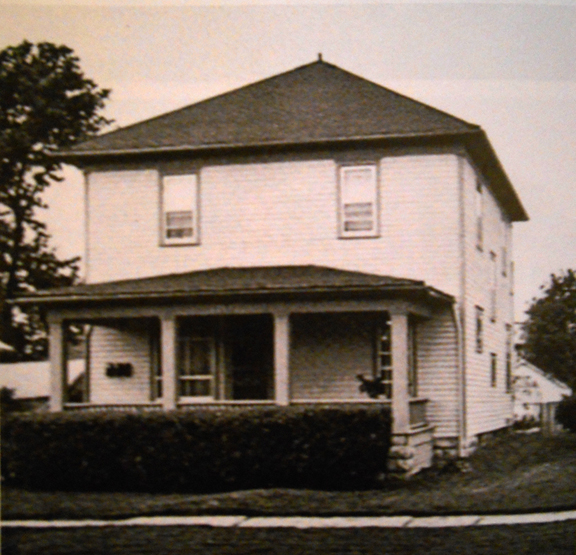
Pyramidal Folk House. Photo from The Field Guide to American Houses by Virginia Savage McAlester. This photo from Emporia Kansas; circa 1915, would have been a contemporary of 1002 North 72nd Street. Note the lack of side-gables or rather the equilateral hipped roof. Thought to require more complex roof framing but need fewer long-spanning rafters and are, therefore, less expensive to build.
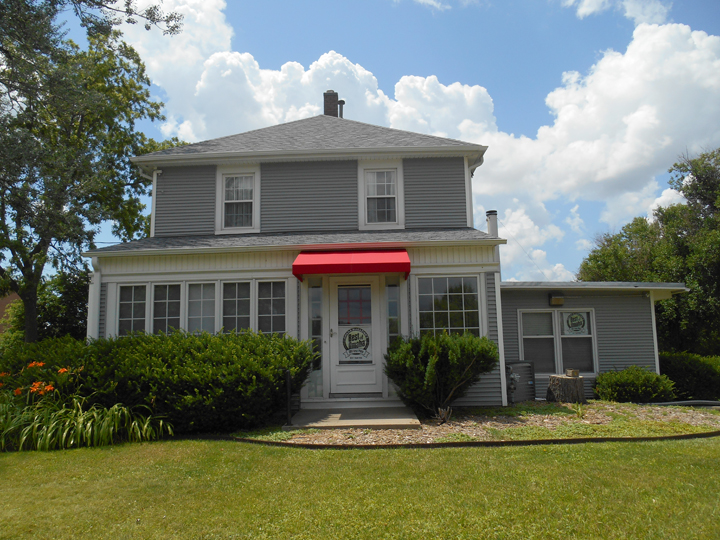
This simplified Foursquare seems in line with my imagined values of the hardworking Porter family. For all I know they were completely Fancy Farmers and I’ve got it all wrong…but I don’t think so. I believed the enclosed porch and the north wing to be additions to the original, simple Pyramidal Folk House design.
I also consulted with American Homes: the Landmark Illustrated Encyclopedia of Domestic Architecture by Lester Walker where he suggested that the Foursquare dimensions made it a perfect mail order house kit. Sears, Roebuck and Company began selling prefabricated houses through their mail order catalog in 1905. Sear would ship precut parts to the building site for a local contractor to erect. This was a widely used service in this time period. Check out these different Sears’ variations on the Foursquare from 1912-1915. If you do not drool over Sears’ home plans, you may want to skip ahead.
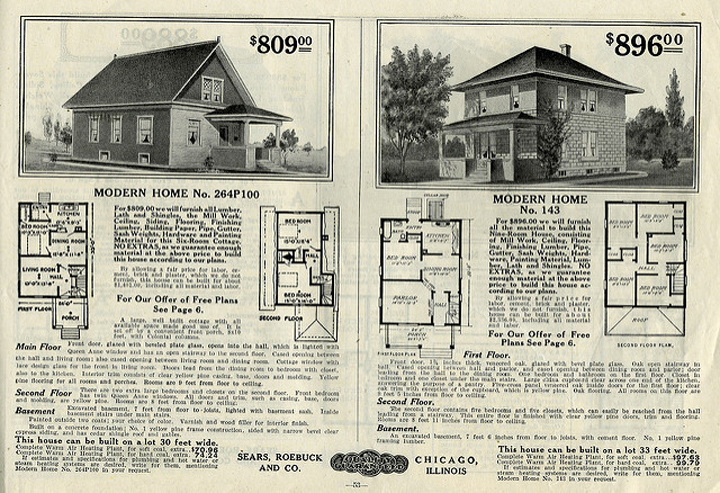
The one on the right.
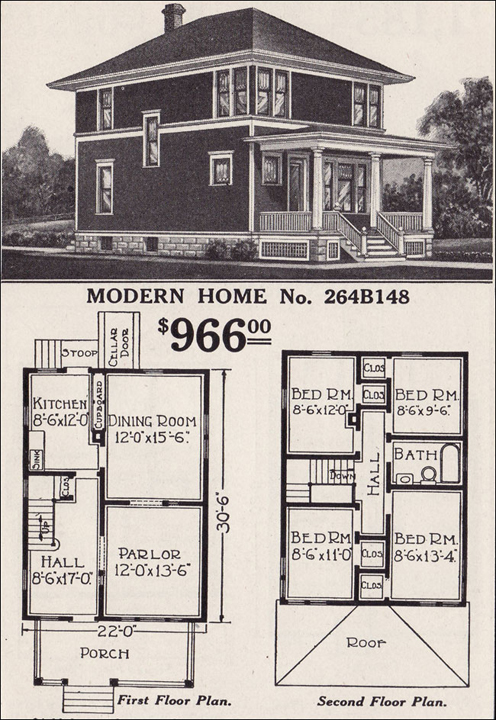
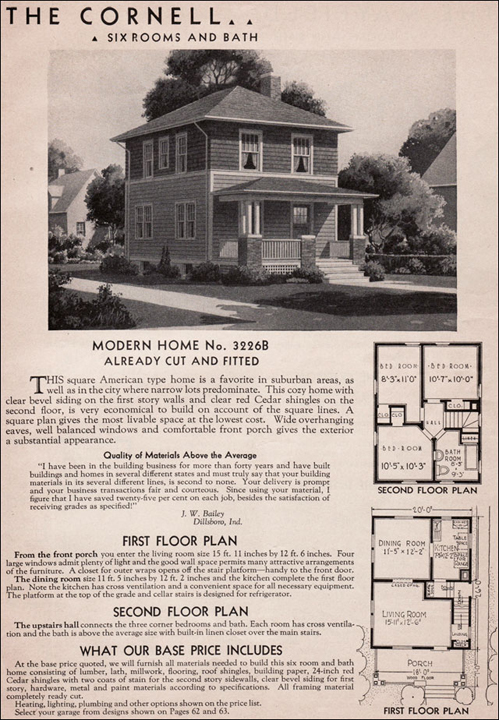
So although I could find no corroboration of a building permit, a contractor or an architect, I believe I have plenty of evidence suggesting the Porters might have ordered their plans and materials and/or built the home themselves.
The Fabulous and Mysterious Porters
Just as a heads up, you might want to begin to take notes. This gets a bit thick. From a 1930 OWH 50th wedding anniversary article, I learned that Benjamin and Margaret Green Porter originally lived in Iowa and moved to Omaha in 1907.
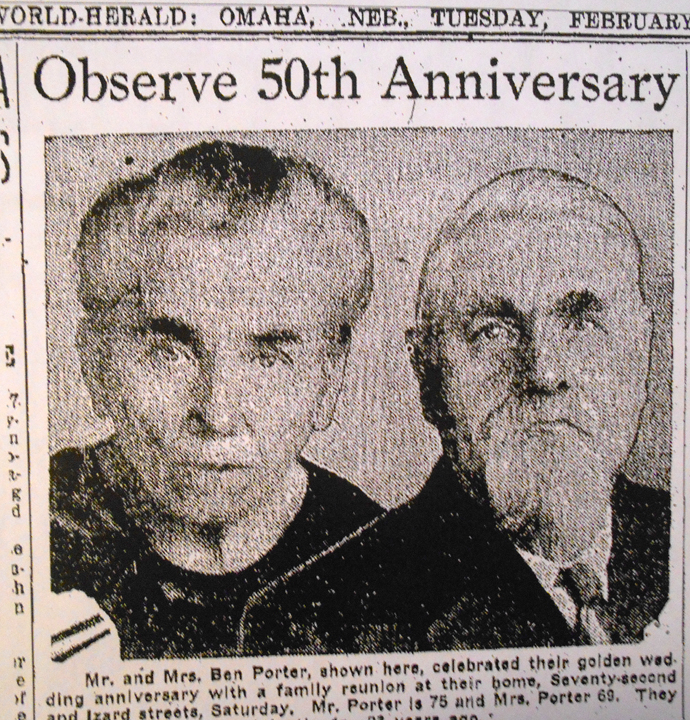
February 18, 1930 Anniversary photo. An absolute goldmine materialized before me when I came across a Porter family member’s laborious archives in Lifestory through the Ancestry site. Apparently Benjamin Porter came to America in 1869 at age 16. He married Miss Margaret Green in Neola, Iowa. This site revealed that the couple had twelve children in eighteen years. My Guinness! I had to investigate this for myself. Using a fine-toothed comb, I reviewed every census, birth record and obituary, I believe the Porters only had seven children. But still, seven. Amazing.
For those fellow obsessives, may I present the Porter children:
Robert James born May 1882
Thomas Franklin “Frank” born May 1883
Agnes Mary born Nov 1886
George born Dec 1889
Benjamin S. Jr. “Ben” born June 1895
Raymond Josesph “Ray” born Nov 1898
Margaret “Ethel” born March 1901

January 11, 1922. Photo from the Ancestry.com site. Daughter Ethel Porter married Antone Bucher. Is this the original north side of the house? Showing part of back porch? It could have been the Bucher home. Margaret and Ben are seen on the right. I reviewed the incredible Benson, Nebraska 1887-1987 book and could find zilch on the farm, house, the Krisels or the Porters. This photo represents the only real personal clue I could find of the family and I treasure it. Thank you to whomever uploaded it.
The Cave Clue
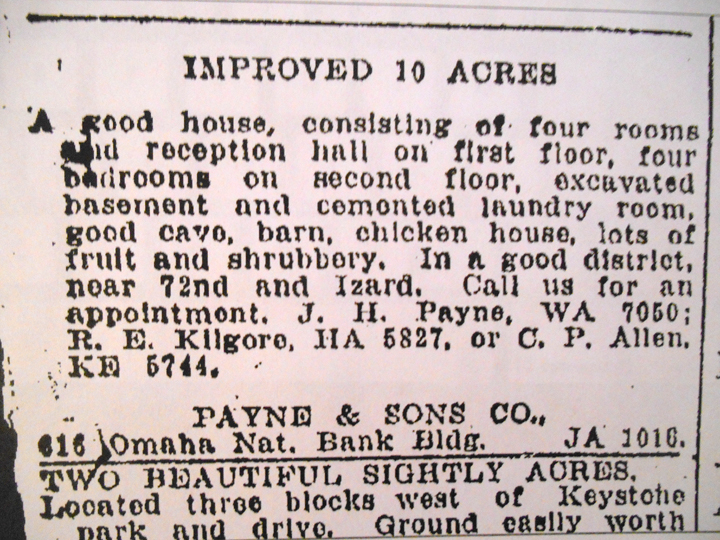
OWH April 16, 1924. Improved 10 Acres. This advertisement sheds light on the original farm. Had the Porters fallen on hard times and were trying to offload their property? Naturally I would question if this was, indeed, their farm or not, seeing as there was no specific address. Just file this away, particularly the 10 acres and the 72nd and Izard part and it will all make sense later. Trust me. This “excavated basement” statement, “cemented laundry room” and “barn.” All to be revealed later. But I must ask that we pause in all of this delicious excitement. Are you, dear Omahans, marveling at this “Good Cave” portion of the ad? A good cave! I think we all know how much Miss Cassette loves a good cave. Check out I Wish I Could Have Gone To: The Cave Under the Hill. What might that have meant and where was this good cave?
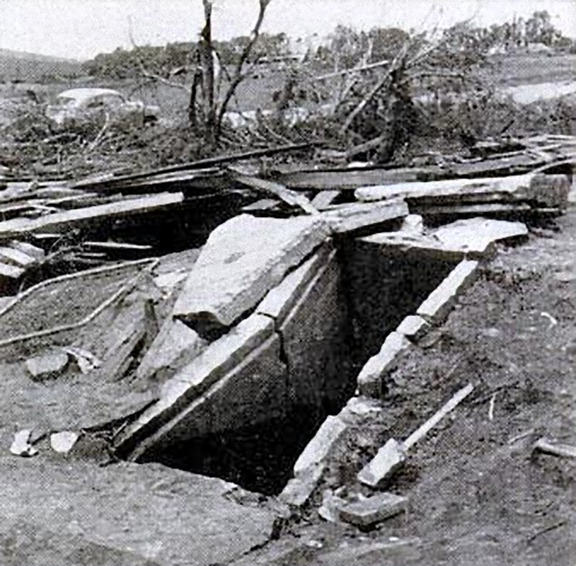
Flint, Michigan Storm Cave 1953.
I cannot be sure that this good cave was a natural occurring phenomenon here on the Plains. That would be doubtful. There are stories of the Pawnee tribes having dug caves throughout the Midwest but particularly in Nebraska. Native People used caves to commune for meetings, use for housing, or store goods. Caves were often dug into the side of a hill but some appeared straight into the ground, like a cellar. Likewise when White Folks began moving into Nebraska, farmers would use caves for their storage, food preserves (think of Grandmother’s cellar), to smoke meats or as a “storm cave” for shelter from tornadoes. A “good cave” would be mentioned in classified ads as a golden selling point for a home or piece of land. I also discovered that when the very early settlers would move into the country they often dug out a cave before even building their house. A primitive dugout could be lived in on the cheap for years until a proper house was built. Some caves showed a great deal of detail and stonework. Check out this article for more information on Prairie life: https://www.nps.gov/home/learn/education/upload/unit%205.pdf. Since my research began on this story, I continue to dream of this cave. Where was it located on the property and who had gathered there? Oh the stories this cave could tell….
Lay of the Land
The Omaha City Directory showed that 72nd Street ran north from Maple to Military in 1928. I did not find it labeled as such, south of Maple.
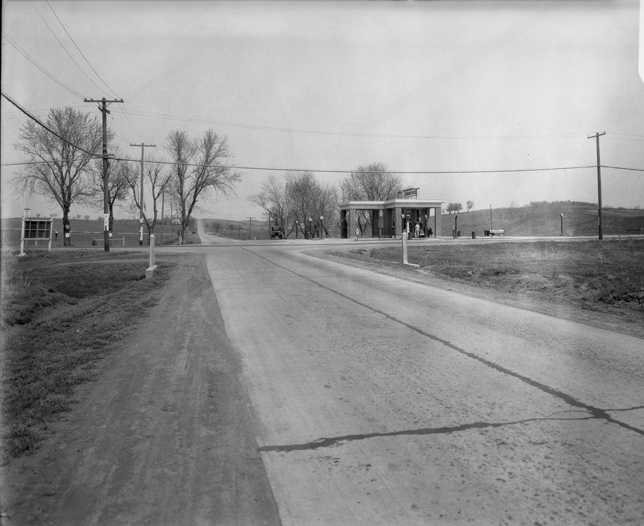
Looking north on 72nd Street from Dodge Street. There is a Standard Oil gas station on the corner. A man is filling his pick-up with gas. May 2, 1928. This photo gives us a good idea of how the street and land must have looked just four blocks up at the Porters. (Photo courtesy of the Bostwick-Frohardt/KM3TV Photography Collection at The Durham Museum Photo Archive).

Stretch of 72nd Street when it was just country road. Note the farmstead off to the left background. June 27, 1929. (Photo courtesy of the Bostwick-Frohardt/KM3TV Photography Collection at The Durham Museum Photo Archive). The road appears paved.
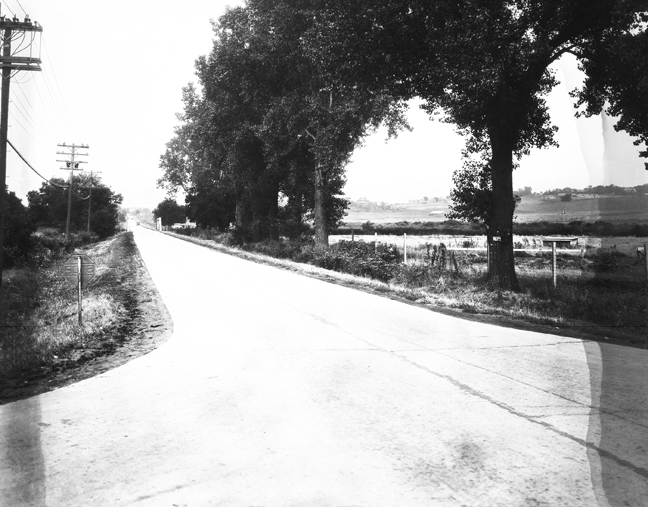
1929. Another shot of 72nd Street when it was a country road. (Photo courtesy of the Bostwick-Frohardt/KM3TV Photography Collection at The Durham Museum Photo Archive). Also worthy of attention, the neighbors to the north and south of the Porters were largely newcomers to America. Many farmers, dairy farmers and caretakers up and down 72nd Street were originally born in Denmark, France, Italy, Germany, and Ireland. This was observed by looking at the different censuses.
Unexplained Deaths
From the genealogy site, I learned that on June 9, 1928, son George died in Omaha at the age 38. No other details were offered. I could find nothing in the OWH. It was slowly driving me nuts. I was able to track a story to a George Porter of Broken Bow. That George Porter had been the Register of Deeds for Custer County. His death was declared a suicide but the year was 1930. There certainly were a lot of Porters, I was to realize.
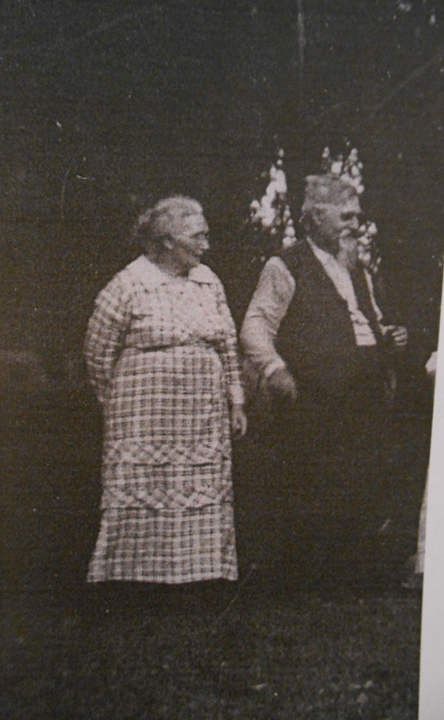
Ben and Margaret Porter photo from Ancestry.com. This was possibly taken at the family’s farm. (Thank you to the family member who uploaded this great image. I would love to give credit if you write me with your information.
The 1930 U.S. Census described the Porters as living at roughly “72nd and Western,” which is north of Izard. An inaccurate logging by the census taker? Put this clue up your sleeve. Ben had retired from farming. The occupants were wife Margaret, sons Robert and Raymond (worked the farm as laborers) and daughter Agnes. I believe the Porters to be a hardworking, farm family. There were no juicy trivialities on the family or attendance at social events to fill in the blanks from local newspapers.
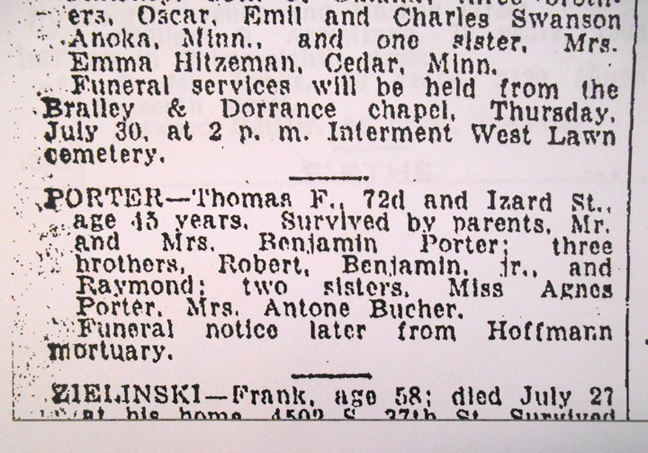
I was surprised to find an obituary from August 1, 1931 for son Thomas F. Porter age 43. At some juncture the Porters’ son, Thomas “Frank” had moved back into the 72nd Street house with his parents. By July 30, 1931 Frank had died in the home or on the property. Death certificate, contrarily, stated he was 45. I cannot be sure of the cause of death but they made a point to say his death was at home. There is evidence that Frank, second to oldest, had been married and was living in his own home, possibly in Webster Iowa by 1925. I don’t need to point out to you, fellow sleuthers, that there is no wife or children mentioned in this obit. But I guess I just did. I cannot imagine what it would be like to bury two of your boys within a few years.
Izard Street Arrives and More Questions
The Omaha City Directory of 1932 revealed Izard Street for the first time at 72nd. I had to backtrack by name, as there was nothing under the address in the street guide. Oddly the Porter farm was placed at “N 72nd 1 north of Izard.” This might be explained by simple accident in logging of data. Previous I noted that the census taker wrote down the Porters living at 72nd and Western. Did the Porters’ original plat also encompass the land north of Izard, where John A. Gentleman Mortuary now stands? Or was this just a case of shifting country roads?
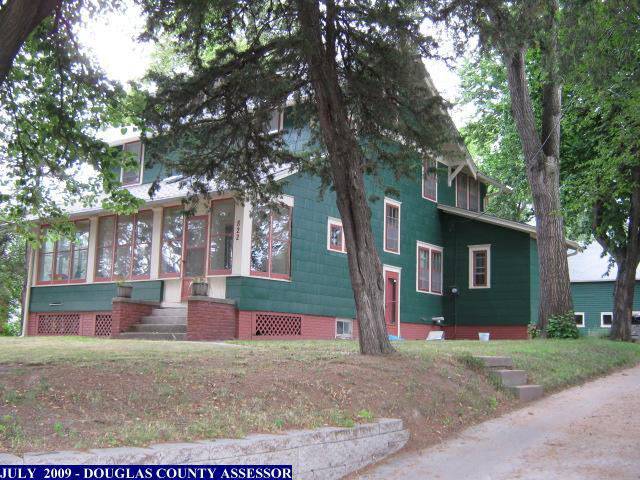
822 North 72nd Street. Photo from the Douglas County Assessor site.
But there was a lingering rumor that the green American Foursquare at 822 North 72nd Street might have been built by the Porters for one of their son. Also a rumor that this land was actually a portion of the Porter’s originally. I was curious about this possible connection. According to the Assessor’s office, this house was built in 1916. Lot 43 Block 0. This land was not a part of the parcel sold by Krisel. None of the Porters lived in or owned this home after a complete scouring of the Deed on this home. Additionally I could find no evidence of a home being built on any of the Krisel lots, to include north of the 1002 home. More might be revealed later.
Mystery Sale
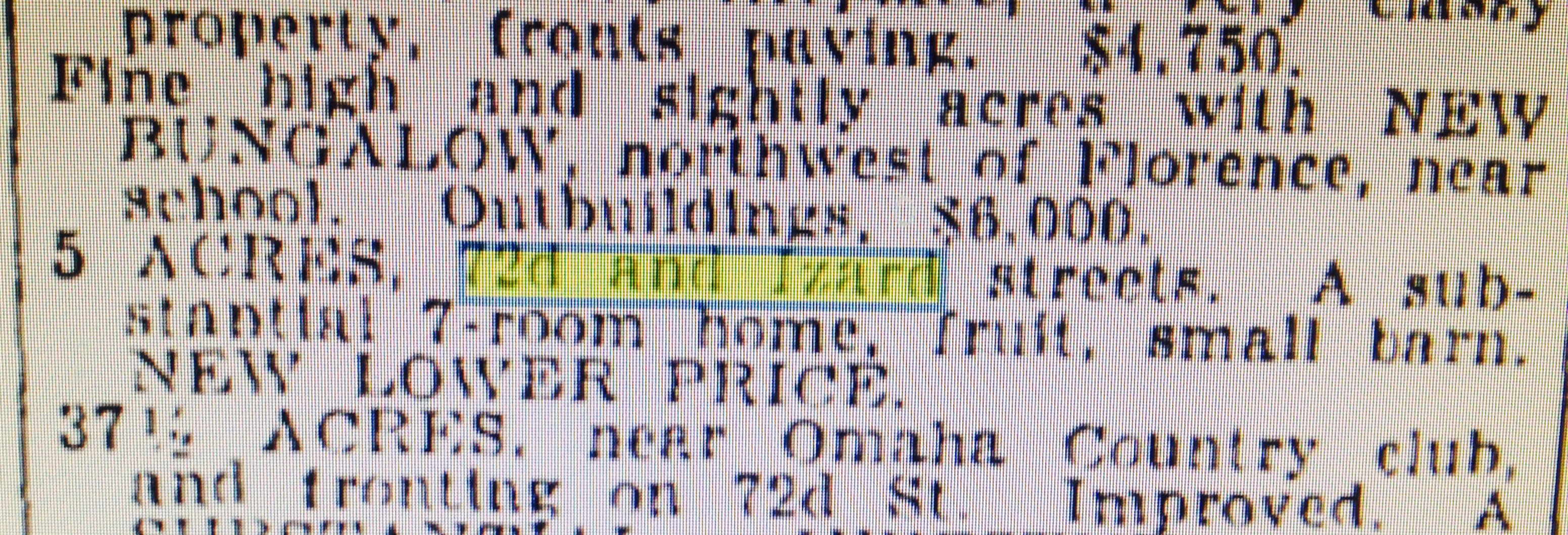
OWH April 7, 1935 five acres for sale. Could this have been a portion of the Porter farm? Were the Porters attempting to sell half of their farm including the house? Does this explain the rumor of there being two Porter homes originally?
Death of Ben

September of that same year, Ben (the father) died at the family home at age 82. His memorial was held in the home at 1002 North 72nd Street previous to the formal ceremony at St. Bernard’s Church in Benson. He is buried at Holy Sepulchre Cemetery. This concept of home wake or memorial in the home was customary of the time. It was also normal for people to expire at home, surrounded by family.
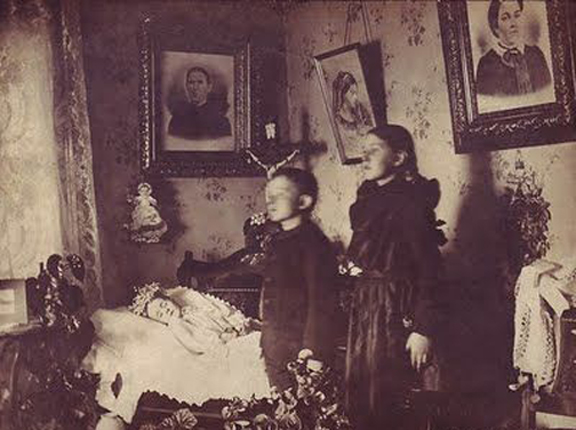
Photo of a home funeral.
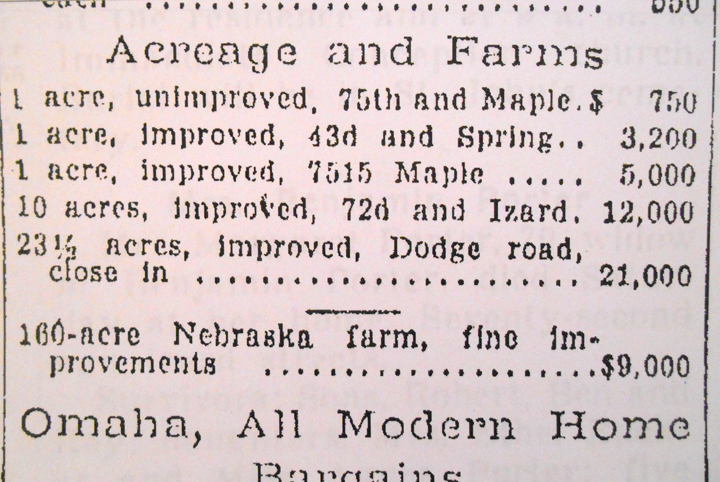
Six months after Ben’s death, the newspaper shows a vague 10 acres for sale at 72nd and Izard for $12,000. Down at the Register of Deed’s Office I tiptoed across: Robert Porter was QDC’d off the deed and it went to Margaret Porter April/May of 1936. Meaning the oldest son’s name was taken off of the deed and it was put into his mother’s name. The Register of Deeds’ office also displayed that Margaret Porter then put the property into her daughter’s name, Agnes Porter at that same time. From what I could uncover, Agnes never married or had children. Mother Margaret remained the head of household according to the Omaha City Directory of 1939. Four others were living in the big house and I suspect they were Robert, Ben, Ray and Agnes, none of whom I found proof of marrying or having children. Not that that is everyone’s life ambition. Just ask Mr. Cassette and Miss Cassette. Still, it was odd for the times.
A New Home Nearby
In the year 1938, a most impressive home was erected at 1025 North 72nd Street, catty corner from the Porter farm. Still standing, the home on the east side of the street has endured many additions over the years to include a church and accompanying offices.
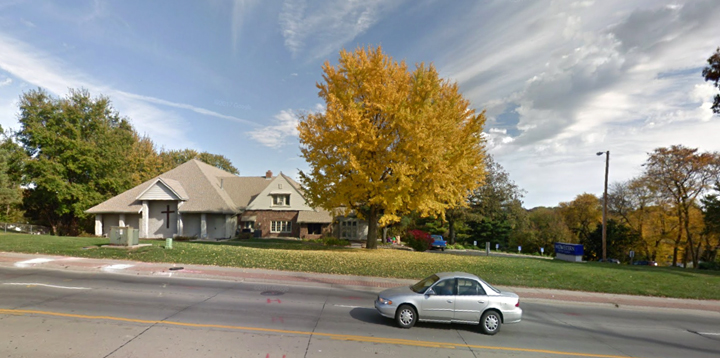
1025 North 72nd Street. Now owned by the Midwestern Baptist Church, the original gorgeous home and large property (three acres?) was a childhood favorite of mine. I would later learn that this was the home of Fred Ware, 47 years the managing editor of the Omaha World-Herald. He infamously instructed his writers, “’Keep it short and make it sing.” A lesson Miss Cassette has not yet learned.
Death of Margaret
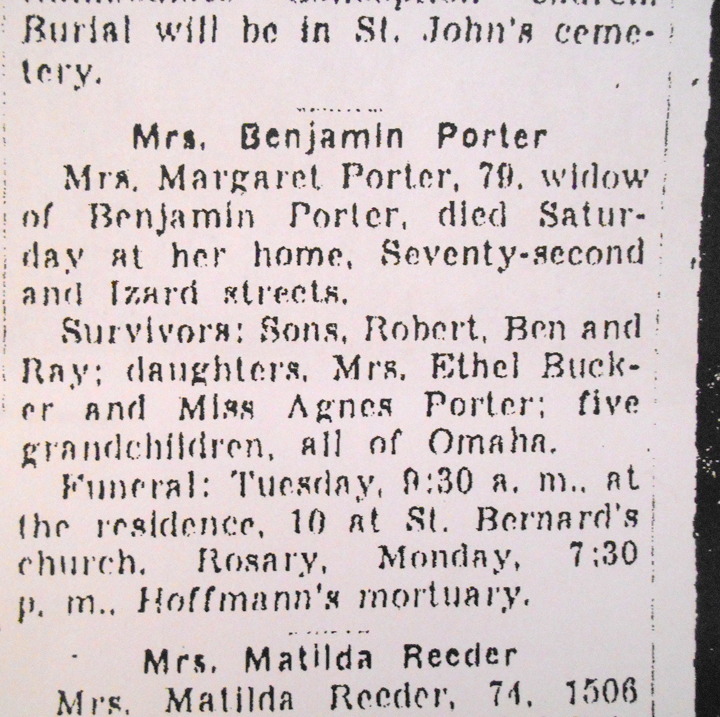
Within a few years, Margaret Green Porter then died in the home, December 30 of 1939. She was 79 years old. The funeral was at the farmhouse, following with formal service at St. Bernard’s Church in Benson. It seems that Ethel and Antone had five children at that point. I so wished I could have known more about this intriguing family. While poring over the details of the estate, I uncovered daughter Agnes Porter “Trustee” sold the home and farmland to Frank A. Berigan in October of 1941. And there a new chapter would begin.

Dear readers, if you are getting weary or feeling neurotic about all of these deaths and confusing property details, may I suggest a cool drink or perhaps a nap? A little respite might do us all well. I will confide in you this one thing before you go. The Porters are where, I myself, got stuck. I have worked on this story since winter, dreaming of and hand wringing over the Porters. Something just wasn’t right. Was it my perceived mystery about the family, the unexplained series of deaths, the occasional listing of the property with no buyers, the unanswered questions about the home and farm that jangled around in my head for all these months? Were the endless, abiding clues too untidy? To quote Nancy Drew “I’m going to keep working on this case until all the pieces in the puzzle can be made to fit together!” So with this knowledge, you know where to find the rest of us when you’re ready. I promise, I won’t be plodding grimly on. We will continue refreshed for the next decades to be divulged. We still have piles of clues to be exposed, cracker jack.
The Berigan Family
I was at once reinvigorated for the chase when I found that a South Omaha legend had taken the reins at our 72nd Street fixation. Frank Berigan, from all accounts, appeared to be an energetic, driven man. Originally from Iowa, Berigan would rise to become manager of the Live Stock Commission in South Omaha.

Frank Berigan. OWH February 1936. This photo is kind of fabulous. Pinto Pete, the horse liked to nip at Frank’s coat until he “got back to work.”
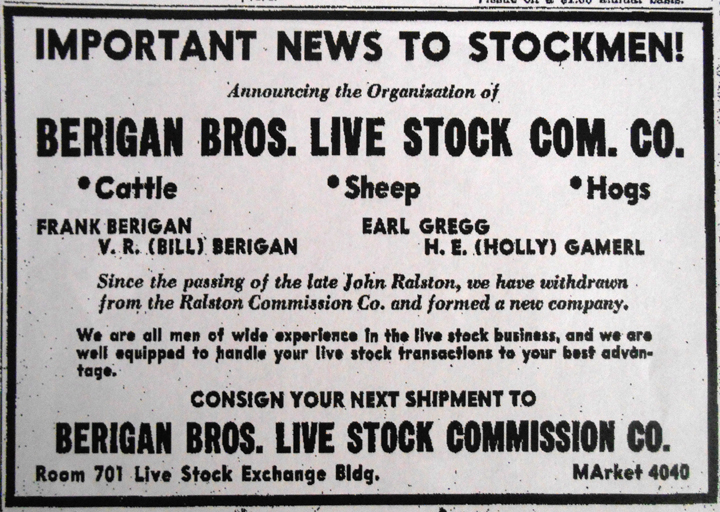
OWH January 13, 1937. Berigan Bros. Frank would start Berigan Brothers Live Stock Commission Company out of the Live Stock Exchange Building with his brother, Bill, after pulling up stakes from the Ralston Commission Company.
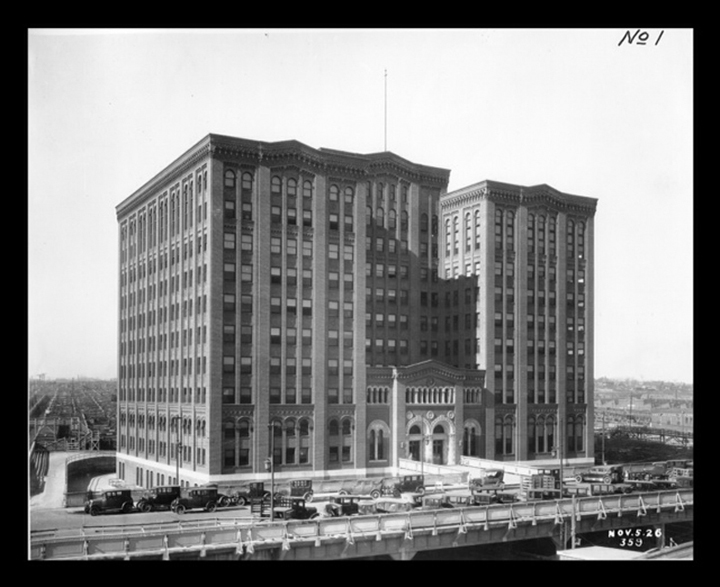
Livestock Exchange Building at the South Omaha Stockyards.
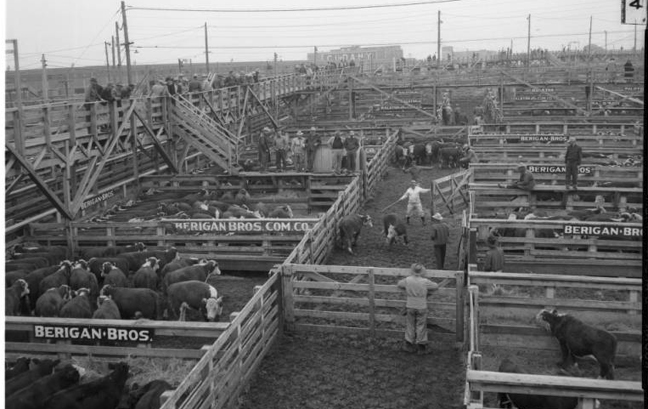
The Berigan Bros Commission Company cattle holding pens. Looks like an auction is being held. Date unknown. (Photo courtesy of the Bostwick-Frohardt/KM3TV Photography Collection at The Durham Museum Photo Archive).
Years earlier, the Omaha City Directory of 1923 described Frank A. Berigan, as a 23 year old yardman at Bowles Livestock Commission Company. His home was listed at 1514 S. 33rd Street. I was pleased to find this house still standing, alive and well in the center of the Field Club neighborhood.
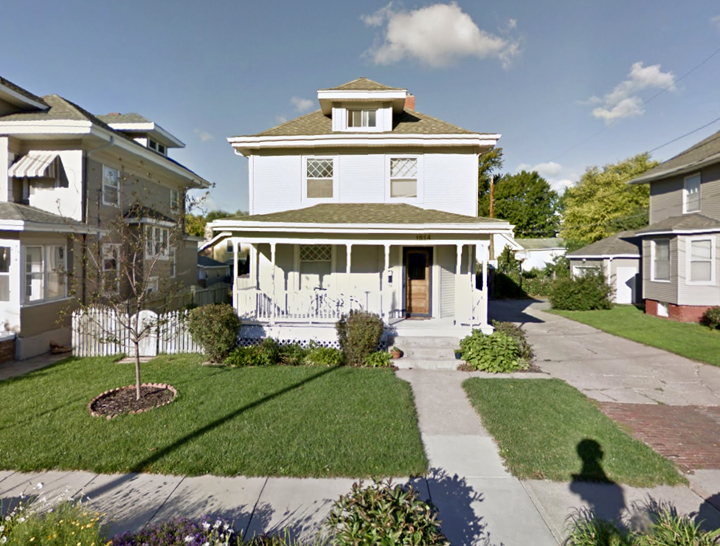
1514 South 33rd Street. Now, this is a classic American Foursquare. Frank’s siblings lived in the home as well. I was interested to see that most of them were stockyard employees. Jonathan worked in livestock. Lucille was a clerk at the Union Pacific Railroad. William (no doubt, brother “Bill,” whom would go on to form the Berigan Bros with Frank) was a yardman at J. H. Bulla & Company. Vincent was a yardman also.

The year before moving to the farm house at 1002 North 72nd Street, the 1940 U.S. Census Frank Berigan, age 40, married to Gladys, age 37. The couple lived at 3001 South 34th Street with their children: Patricia 15, Frank Jr. 12, Bernard 9, Alfred 6 and their housekeeper, Minnie Rabiola, age 23, from Iowa. This fine home is well preserved and in the Hanscom Park area, south of Center.
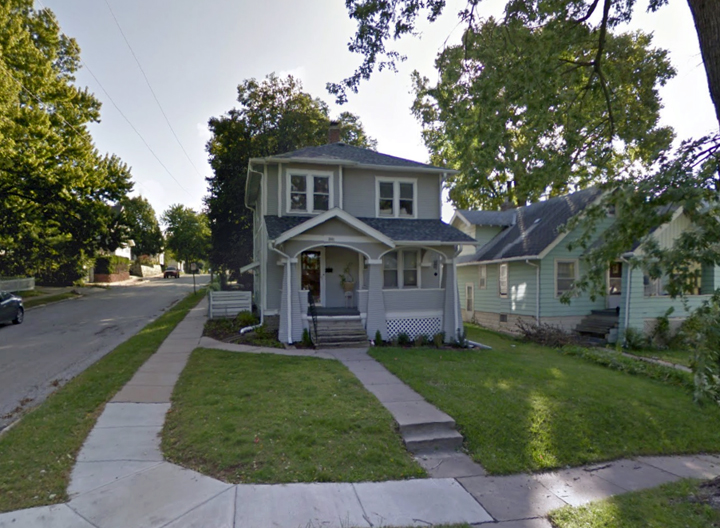
The Berigan Family home in 1940. 3001 South 34th Street. Loads of neat architectural details on this home. Love when I find they are still standing.
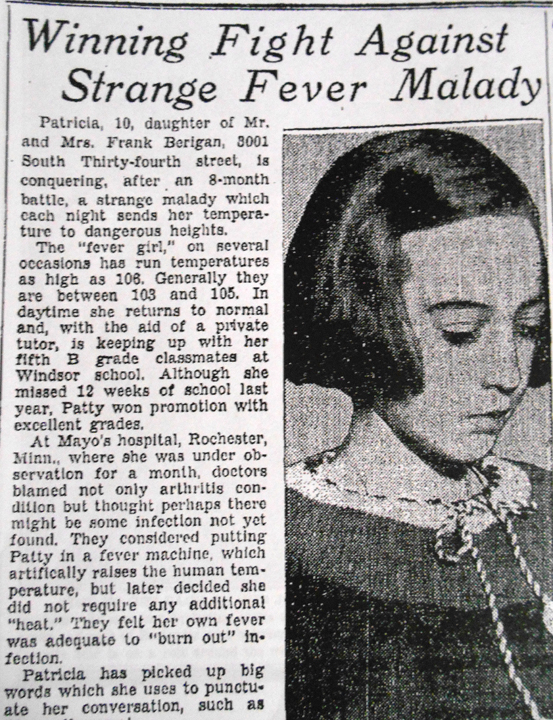
Earlier still December 8, 1935, the Berigans’ oldest daughter, Patricia Ann, made headlines by conquering an eight month battle of nightly high temperatures, in the range of 103 to 106 degrees. Patty was sent to the Mayo Clinic and was believed to be “burning out the infection.” The article hinted at arthritis as a cause. Although Patty missed twelve weeks of school at Windsor, she was noted for attaining excellent grades with the help of her private tutor. I was happy to find proof of Patty’s enduring health and good marks. Evidently, young Patty was an exceptional student and would go on to receive state attention when she received the Hitchcock scholarship in 1946. Patty would later marry Warren D. Leary, Jr.
1002 North 72nd Street
An article from the World Herald, dated, July 25, 1943 gave indication that the Berigan continued to use the property at 1002 North 72nd Street as a farm. “Highly bred Guernsey bull calf, week old. Reasonable. GL 2280 1002 N. 72 St.” As an aside, even by 1953, the city directory had dropped Izard Street as the cross over, listing “Underwood Avenue intersects” at 1022 North 72nd Street. This area was still considered rural with occasional farm homes along the route. Can you imagine the drive from this address to South Omaha in those days? Sounds kind of nice, actually.
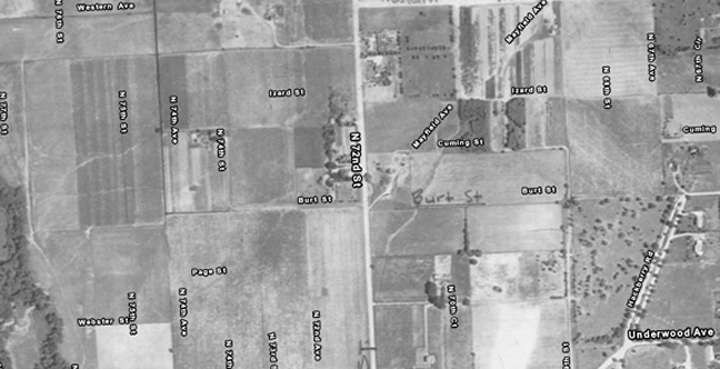
Here is an 1941 aerial photo of the 72nd and Izard corner. One can see that Izard Street moved over time because the shelterbelt and farm is nowhere near the labeling or maybe that is a mapping problem? At any rate, it is plain to see that this Midtown area was once rural for as far as the eye could see. Photo is from the GIS Mapping site.

By 1945 the six Berigans all continued to live at 1002 North 72nd according to the City Directory. I found son, Frank Berigan, Jr’s yearbook photo.
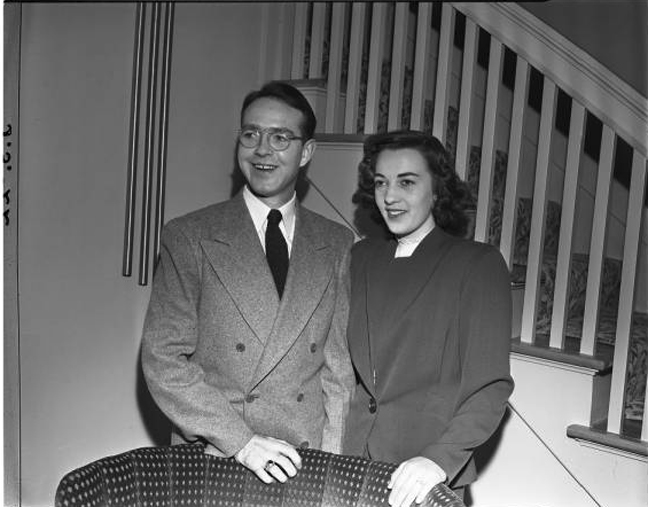
Here is Pat Berigan all grown up and quite striking. She and an unidentified man stand in front of a staircase. Is this Warren Leary, her husband to be? Is this the staircase in the farmhouse. April of 1947. (Photo courtesy of the Bostwick-Frohardt/KM3TV Photography Collection at The Durham Museum Photo Archive).
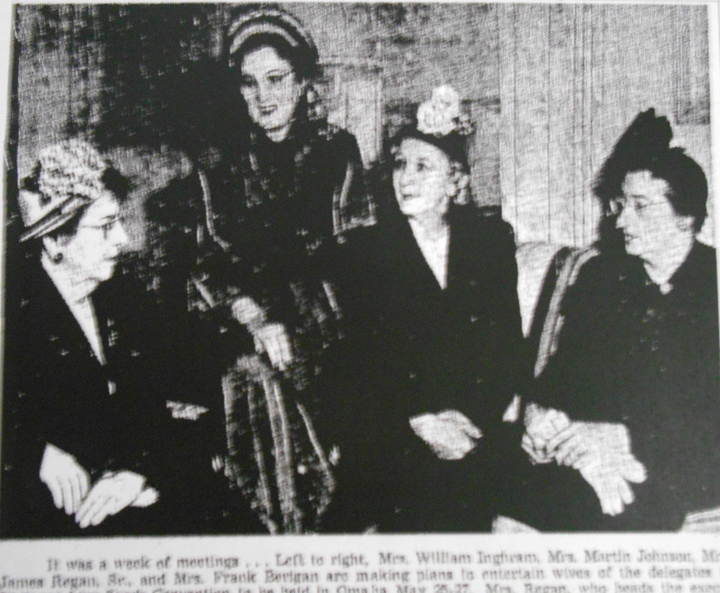
April 23, 1950. Here was find Gladys Berigan on the far right, heading up an executive committee charged with planning a luncheon for the wives of National Live Stock Convention delegates. Love it. I only pray that a fruit cup or three-bean salad was involved.
New Spiffy Ad as a Clue
I tip toed across a great advertisement for the home in May of 1954, describing the home as a small country estate on 10 acres. I liked the professional marketing and could envision this oasis in a new light. I wondered why the Berigans were moving on but living in the home thirteen years might have been a long time by some people’s standards.
**Addendum of July 15, 2017**
Bret Berigan, grandson of Frank and Gladys, son of Alfred Berigan, shared that his grandparents then moved from the farmhouse to 314 South 93rd Street. I found this home in the Westchester Addition. Interesting, as I’ve been working on another home in this very area– A family who probably knew the Berigans.
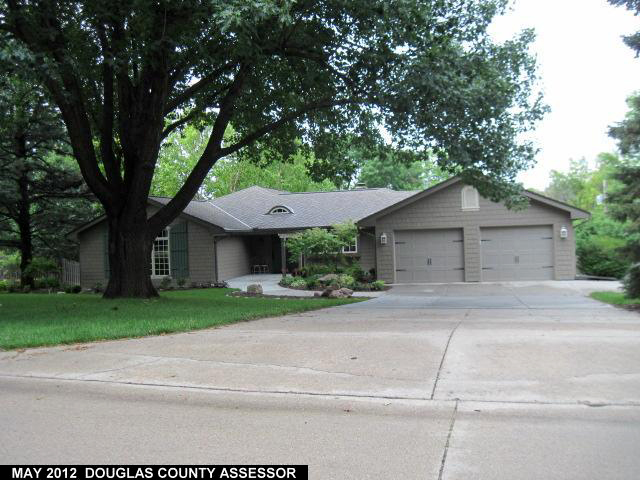
Photo taken from the Douglas County Assessor site. Reportedly built in 1956, two years after the Berigans sold the farmhouse. The Assessor’s site is sometimes a bit off on their dates. This stylish ranch has some great details. I am partial to the winking eyelid window above the darkened entry way and that decorative gable vent on the garage. Little architectural touches that take make a house sing.
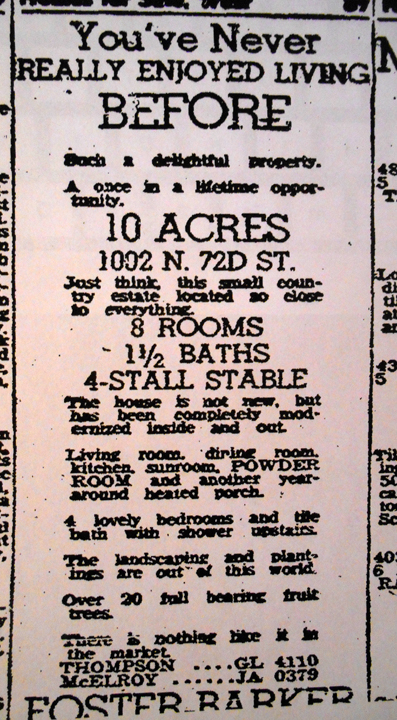
OWH: May 2, 1954. 1002 North 72nd Street came complete with 10 acres, giving credence to previous suspicions. The barn was now renamed a “four stall stable.” I would learn later that the Berigans had kept horse, so this all fit together spic and span. Clever, simple phrasing hooks the reader into an enchanted life complete with a sunroom, a powder room, rural but near to everything and a year round, heated porch. I imagined that the Berigans made these modern additions that we had seen in the previous photos. No mention of a cave however. Now where was that cave?
A Glimpse of Lillian Stern
I again reviewed the deed archives at the downtown office and found that the home was sold in October of 1953, months before this spring ad was actually run. I found that Frank Berigan and wife sold 1002 North 72nd Street to Lillian B. Stern. Lillian B. Stern and husband turned and sold the home in June of 1954, eight months later. Was this a flip? My land, I believe it was. According to clues I turned up, Lillian Stern was a realtor or worked for one. From the 1950s through the 1970s I found Lillian Stern mentioned in a plethora of real estate ads selling homes. Stern worked for N.P. Dodge at some point in her career. I also discovered when her mother, Ida Friedlander, passed away and later her brother, Morton Friedlander, that Lillian was originally Lillian Friedlander. The clue to her profession explained the well-crafted marketing of the home in 1954 and that the Sterns had potentially made those modern updates to attract new buyers.
It is at this point that the story really kicks in. And it begins with a twist. Or perhaps it doesn’t. Perhaps it begins with the ushering in of the modern era. A troubling situation frequent in any city: impending big development. Please rest up or walk around the block, your choice. When we meet up again for Part Two be prepared to search for a secret passageway, a moving bookcase, a trap door under a Persian rug or at the very least steel oneself for a good thrilling chill.
This investigation now has a Part Two, just waiting to be surveyed by you. When you have time, check it out at Mysteries of Omaha: 1002 North 72nd Street Part Two.
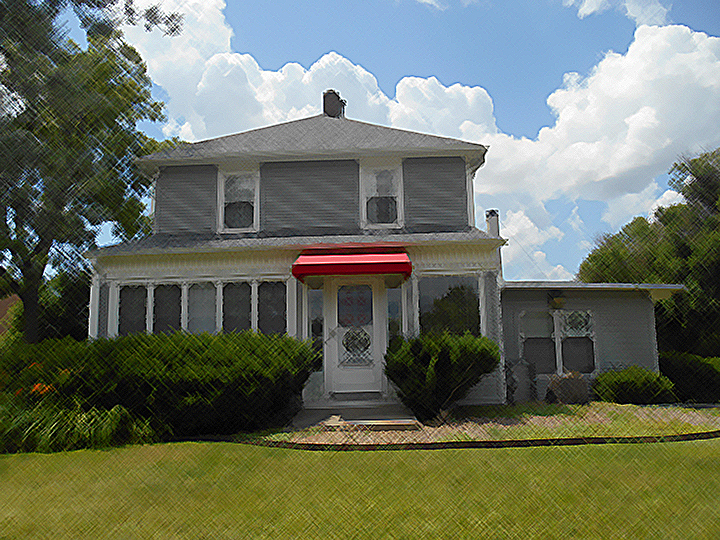
I welcome your feedback and comments on this home, its history of incredible owners and the 72nd and Izard area. If you have any information on this house, we want to hear from you! To comment, please scroll to the end of this page. If you would like to correspond with me privately, please do so at myomahaobsession@yahoo.com or in “Contact.” But be assured, everyone would love to read what you have to say and it makes the conversation more fun. You can keep up with my latest investigations by “following” myomahaobsession. You will get sent email updates every time I have written a new article. Also join My Omaha Obsession on Facebook. Thank you Omaha friends.
© Miss Cassette and myomahaobsession, 2017. Unauthorized use and/or duplication of this material without express and written permission from this site’s author and/or owner is strictly prohibited. Excerpts and links may be used, provided that full and clear credit is given to Miss Cassette and myomahaobsession with appropriate and specific direction to the original content.
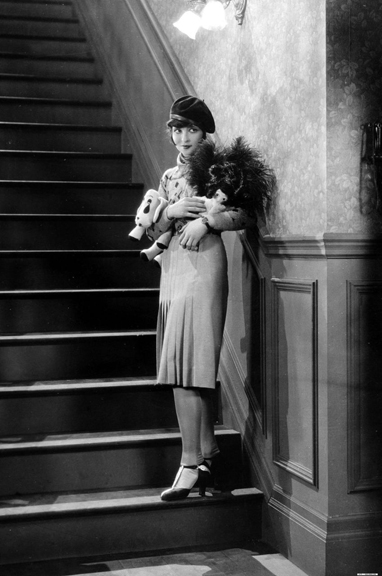
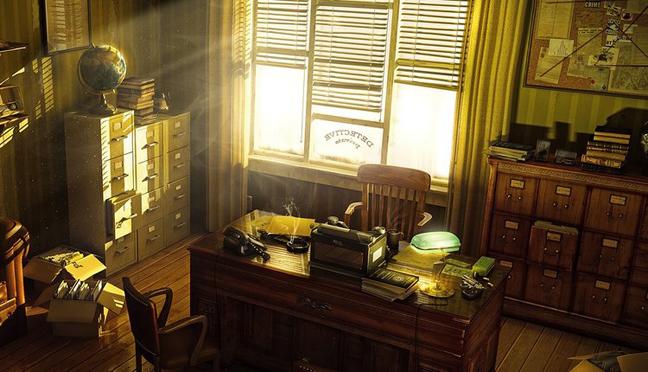
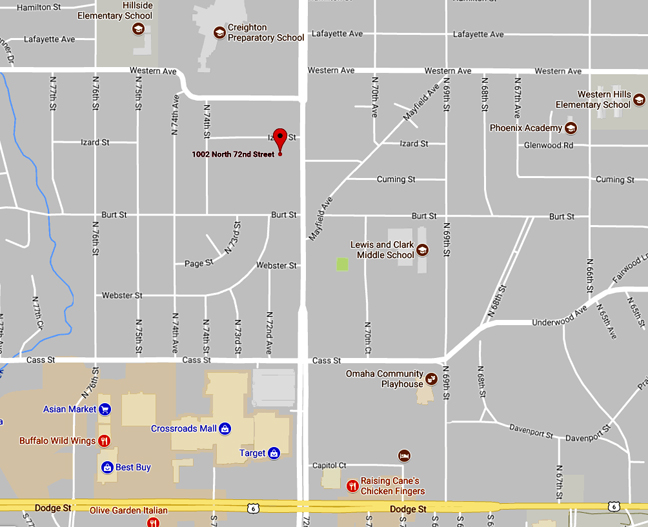
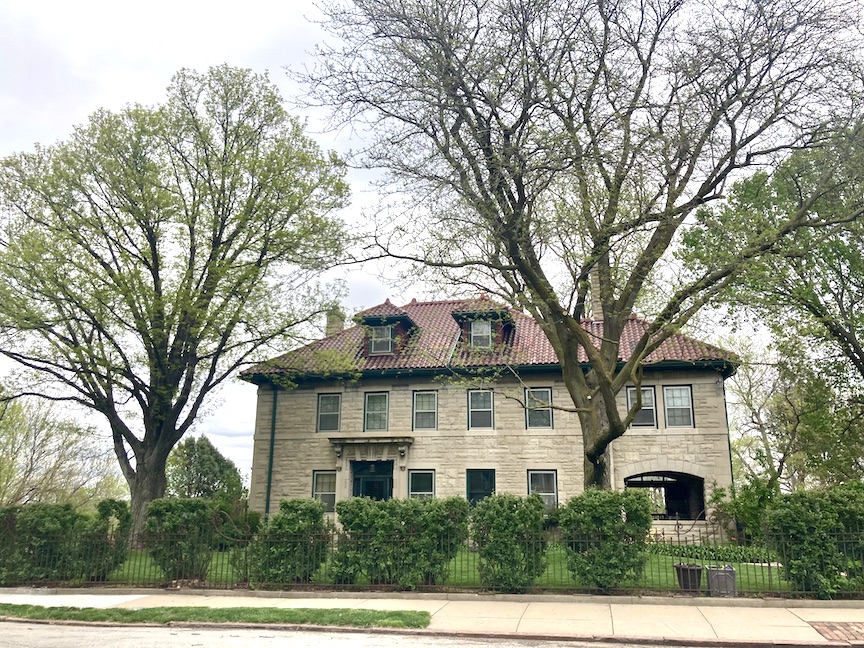
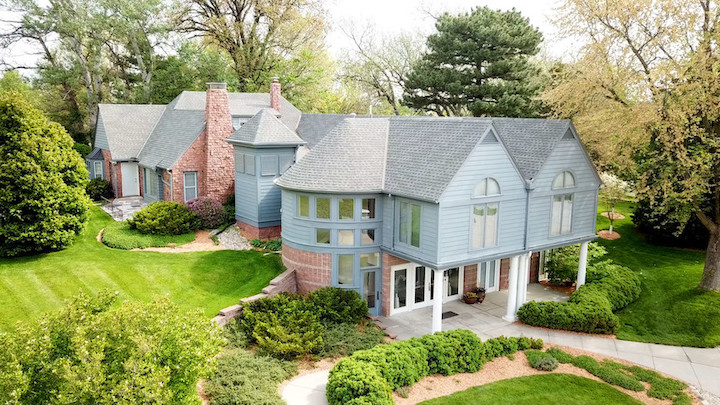
This was a very interesting article and answered so many questions I have had about this property. I teach at Montessori Children’s Room, part of which is included on the map of the original farm land. Quite coincidentally, we had a student who attended MCR named Benjamin “Ben” Porter! I live in Benson and drive past the house almost daily. Always suspected it was the farmhouse belonging to the land our school sits upon. I have been inside twice when it was a day spa. It was lovely then and I hope it still is. Cannot wait for part two of this article. Love your writing, Miss Cassette!
Oh my gosh, this is so cool! So you work to the south of Underwood Hills? I am not 100%, of course, and maybe someone will come forward with more clues but I think that where you work would have been the original farm of 822 North 72nd–the green house? It is driving me nuts…thanks for writing in and you’re nice words. We’ll figure it out some day.
Yes, I think most of the school building is on the green farmhouse land, but a corner of the building and much of the grounds are sitting on the 1002 farm land, according to your wobbly line on the arial map. Just read part two. Wow, so great to know more about this history. Did I mention I live in an American Foursquare? Hope to see some sleuthing of the green house someday.moo m
My cousin Rory Berigan discovered this article and posted it on Facebook; we’ve now shared it further with other Berigan cousins. Rory’s grandfather was Vince “Bill” Berigan. My grandfather was Frank Berigan Sr. Pat Berigan was my mother, and the young man pictured with her is indeed my dad, Warren Leary. The photo was taken when they announced their engagement. Of the family that lived in the farm house, only Bernie Berigan is still living. Bernie, by the way, was the first coach if the Omaha Mustangs football team. There is a lot of Berigan material (photos, typed letters, Stockyards business materials) that the family has donated to the Nebraska Historical Society. This photo in particular might interest you: http://contentdm.unl.edu/cdm/singleitem/collection/nebraskastu/id/12015/rec/11. Some of Frank Sr’s typed letters probably refer to family activities at the farm. There is a funny news article somewhere on “the Berigan’s bad day” recounting a chain of mishaps, all in one day, involving the dog and family members .
Thanks for your detailed research. Oh, by the way, Grandma Gladys Berigan surely made more than one three bean salad in her day!
Hello Sheila, I devoured your comment! How great to hear from you. Your mother was a striking beauty. I do appreciate your additional details and anything any of you would want to add would be much appreciated. I can add addendums as more comes forward. What a great family you have.
Thanks for sharing this wonderful information on my family’s history – I really enjoyed seeing the pictures of the homes my dad grew up in and seeing all the information about my grandparents Frank and Gladys Berigan. FYI my grandparents moved from their home on 72nd Street in 1954 to 314 S. 93rd St – another good address!
Thank you for their “next address” tip. I will add that to the story. Please feel free to encourage anyone with additional info to send it on to me or comment here.
I really appreciate this!
can you fix “Beringer” to read “Berigan” in the headline “The Beringer Family” … thanks so much !
Absolutely! Thank you. I need an editor, it is true.
Thanks for the update on my grandparents’ move to 93rd Ave in 1954 from this great property and home. Please correct to read that I’m the son of Alfred Berigan. Thanks!
I stumbled upon your website today and have spent a fair amount of time reading. I lived at 1029 N 72nd Street from roughly 1980 to 1993. As kids we used to go to a rickety old playground behind the church and walked by 1002 many times… not knowing who lived there nor the history. being neighbors to Mrs. Ware next door at 1025, I had no clue her husband was the managing editor of the World Herald for 47 years. She was just the nice old lady that handed out balloons for Halloween and was happy to give us toys when we accidentally kicked a ball over the fence into her driveway or came over for a visit. Thank you for the work you have done and it was very fun and interesting to learn all about the house across the street.